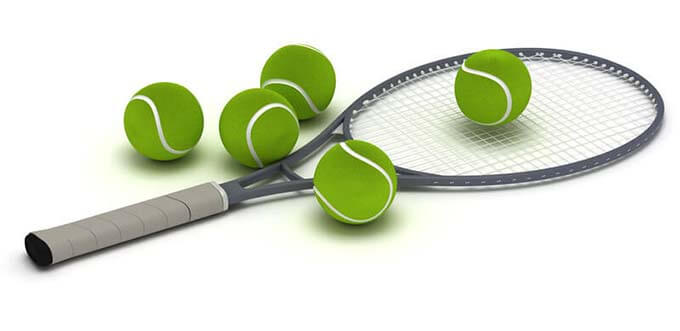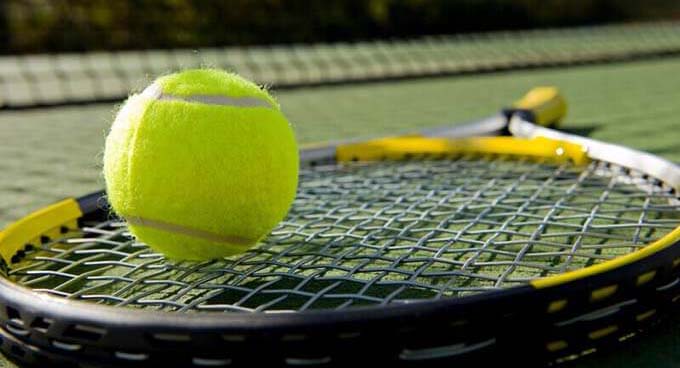
It is the dream of every aspiring tennis player to play at Wimbledon. The grass courts set this Grand Slam apart from all others and if the traditional rain holds off, there will always be great matches to remember.
Table of Contents
- 1 Wimbledon tennis racket stringing team
- 1.1 When does preparation start for Wimbledon?
- 1.2 Teamwork when stringing tennis rackets is important
- 1.3 How much do racket stringers get paid at Wimbledon?
- 1.4 What time do the Wimbledon tennis racket stringers start the day?
- 1.5 How much tennis racket string is used at Wimbledon?
- 1.6 Tips for improving swingweight
- 1.7 Busiest racket stringing day
- 1.8 Special treatment for the top players at Wimbledon
- 1.9 Running quality control on tennis racket stringing
- 1.10 How may stringers does it take to string a racket?
- 1.11 Monica Seles holds the highest racket string tension title
- 1.12 Lowest tennis racket string tension
- 1.13 Restringing a tennis racket due to temperature changes
- 1.14 Anna Kournikova’s tennis string in demand
- 1.15 Tennis racket from hell
- 1.16 Poor-quality tennis strings can cause injury
- 2 Tips for reducing tennis elbow and other tennis-related injuries
Wimbledon tennis racket stringing team
Right at the heart of this massive tennis event and situated alongside the Practice Courts, are two portacabins that house a team of workers that play a vital role at each Wimbledon Championship. They are the Official Racket Stringing Team and they will be there from before day one through to after Finals Day.
For the past 20 years, the work has been carried out by Kings Lynn based Bow Brand International who has been producing natural gut strings for the racket industry for over 100 years. Their Head Stringer for 2001 was myself and here are a few snippets of information that may be of interest.
When does preparation start for Wimbledon?
Wimbledon preparation starts just after the last one. There is so much to organise that the whole year is spent doing some type of preparation. Machines and other equipment have to be serviced, top quality stringers need to be found and of course, they will need to be accommodated, not an easy task during Wimbledon.
Teamwork when stringing tennis rackets is important
The sales manager at Bow Brand receives hundreds of requests from stringers all over the world who wish to experience the unique atmosphere of Wimbledon. Each application is carefully looked at and selection will be based on several factors such as technical skills, certification level, previous tournament experience and ability to work as part of a close-knit team. Being the fastest stringer or being best known, does not get you to the front of the queue!
How much do racket stringers get paid at Wimbledon?
The eventual 20 strong International teams will come from many countries including the US, Canada, Holland, Belgium, Germany, Czechoslovakia, Greece and Japan. The stringers will pay their own travelling costs but will receive a daily pay rate of £65.00 for a typical 12 hours day. Many will be housed close to the All England Club at nearby Southfields. A small terraced house can be rented out for around £1000 per week, so some local residents choose to have their holidays at this time.
What time do the Wimbledon tennis racket stringers start the day?
The stringers will make the 20 minutes walk up to Gate 5 each morning and can be stringing rackets by 7:30 a.m. As Head Stringer, I would have been there from 7:00 a.m, checking the machines were functioning correctly and talking with the Graveyard Shift, a bunch of four stringers who would have been working through the night to get around 45 rackets serviced by the next morning’s 10:00 a.m deadline.
How much tennis racket string is used at Wimbledon?
A total of approximately 8 miles of synthetic string and 6.5 miles of natural gut string will be used in over 2600 rackets for over 500 players at the Wimbledon Championships. Synthetic tennis string is mostly either nylon or polyester based. There is a progressive move towards the very durable polyester strings by professional players who like the rather dead feel and added durability for heavy topspin play. Most of their matches throughout the year include clay courts where the softer nylon strings will quickly perish.
Tips for improving swingweight
Two kilos of lead tape disappear in the highly technical Racket customisation process for the top players. Small amounts of lead strips can be placed at strategic points around a racket frame to alter the balance, overall weight and what is called swingweight, or dynamic weight. This is a measure of how the tennis racket feels in the player’s hand. Although each new racket from the factory will look identical, there will be slight differences in specifications and professional players need to have each racket identical in every respect as they are taken out of the bag at courtside.
Busiest racket stringing day
Busiest days will be in the first week of match play and can see over 200 rackets serviced within a 24hrs period. Crunch time is 10:00 a.m each day, with players and coaches arriving to collect tennis rackets for practice. Each tennis racket must be ready on time. The desk staff are as busy as the stringers and having good interpersonal skills, fast brains and lots of patience is valuable.
Special treatment for the top players at Wimbledon
Several top players at Wimbledon will have an allocated stringer who will look after their racket servicing throughout the Championship. This removes any variation in the way the racket is strung. Coaches like to eliminate variables and keeping things the same is a big gain. Each racket servicing can be traced back to the stringer and machine by the desk staff.
Running quality control on tennis racket stringing
Wimbledon stringing requires top-class equipment to complement the skills of the stringing team. Up to eleven electronic Babolat stringing machines will be located within the stringing cabin at the All England Club, with another two or three at the Roehampton Qualifying Tournament in the first week of practice. The Head Stringer will check each machine at the start of each day to ensure that the tension calibration is accurate. He/she will also allocate the incoming stringers to each machine and be responsible for the overall technical quality of the stringing work and the operational management of the whole team.
How may stringers does it take to string a racket?
There will be one stringer to each machine, with a relief stringer covering for rest break so that all machines are fully utilised at all times to keep the work flowing smoothly. As each racket is strung, it is stencilled by one of the desk staff or relief stringer and packaged for collection. Incoming rackets are stacked in order of priority with match rackets having priority over practice rackets in the rare event of time being too tight.
Monica Seles holds the highest racket string tension title
The highest string tension over past years is still held by Monica Seles, with an incredible 92 lbs in her oversized Yonex racket. The Babolat electronic stringing machines could not reach this high tension and so a manual machine was modified. The racket frames would occasionally break under this high tension and as this would cause some nervousness amongst the rest of the team, the Head Stringer would be confined to the tea room to do all Monica’s rackets, emerging later with some added grey hair! Not a job for the faint-hearted.
Lowest tennis racket string tension
The lowest tensions recorded for a tennis racket belong to Michael Chang’s brother and coach, Carl Chang. He went as low as 31lbs, which is what a squash racket would be strung at. The maximum is “String tight for control and loose for power” and anyone seeing Carl Chang’s serve would agree.
Restringing a tennis racket due to temperature changes
A fall or rise in air temperature of more than 2 degrees will prompt many top players to have their string tensions adjusted to suit. Balls tend to fly in high temperatures and so the string tension is raised to gain more control. A drop in temperature can mean that string tensions need to be lower to allow the strings to get the ball further into court. It is not unusual for a player to have around five rackets strung perfectly in the natural gut, return after 20 minutes of practice and decide to have them all strung again at a lower/higher tension. It was always a shame to see perfect – and unused – top-quality string being chopped out of a frame.
Anna Kournikova’s tennis string in demand
Little people – Each year there are organised visits by schoolchildren and they always ask for the same thing – the string that has been cut out of Anna Kournikova’s racket! So we had to save every scrap for them or they would gang up on us.
Tennis racket from hell
There are easy and difficult rackets to string. The worst was a batch of three Head Prestige rackets for Tommy Haas, done at 11:30 p.m., high tension of 63lbs, poor quality Babolat natural gut and damaged string grommets. All were done correctly, I missed the pub but once again the player got his rackets on time for his match.
Poor-quality tennis strings can cause injury
We are still one of the few countries that import rackets already strung. They will usually have cheap string installed and this can cause the racket to play terribly. Most decent players will always ask for the factory string to be cut out and then select a string and tension that best suit their particular playing style. Unfortunately, a lot of poor quality strings that play badly are also quite durable and the player’s arm and shoulder may suffer for a long time before the strings mercifully break. By that time many players may have developed Tennis Elbow and other complications.

- RACKET FLEX – Have you got the right racket? Each tennis frame will flex a little or a lot. The less it flexes on contact with the ball, the more shock is driven into the elbow tissues. Look at the width of the racket “hoop” The narrower it is the better for your elbow.
- STRING CHOICE – Natural gut string is an absolute saviour for players with tennis elbow. Yes, it is more expensive but the benefits are immense. Natural gut has the ability to absorb harmful shock whilst still delivering an unmatched power return to the ball. Stay well away from Polyester and Kevlar Hybrids. About 30% of Eastern European players spend 3 months or more each year, out of competition with tennis elbow, mainly due to their use of cheap polyester strings.
- STRING TENSION – Lower the string tension of your racket. This will allow more of the impact shock to be absorbed and will deliver more power to your shot. Most of the top professionals shy away from high-string tensions. Tensions of around 53 lbs for a normal size frame (95 sq ins) are about right.
- RACKET MASS – Avoid ultra-lightweight rackets. The more mass you have available to meet the ball, the less worry for your poor old elbow. If you cannot be parted from your lightweight racket, then ask a competent stringer to add lead weight to the frame around the 3 and 9 o’clock positions. Use a qualified stringer.
- INCREASE GRIP SIZE – Use a towel or similar to see what is the biggest grip size that you can handle and then use a normal grip or thinner overgrip to adjust your racket. Do not use more than two grips, as the natural feel of the flat surfaces called bevels will be rounded off. A qualified stringer will be able to add heat shrink sleeves to build up the grip size and retain these bevels.
- SOFT GRIP – Use a cushion grip, as this will absorb much of the shock.
- VIBRATION DAMPERS – are effective in dampening out those harmful vibration frequencies that are particularly damaging to the tissues of the outside of the elbow joint and rotator cuff in the shoulder joint.
Stay away from steroid injections for tennis elbow, if possible
Steroidal injections are an absolute last resort and are NOT a solution to Tennis Elbow. They will allow a quicker recovery but are totally useless and potentially dangerous if the recovering player walks back into the same old trap. The above seven golden rules have got many young and seasoned players back onto the court, they get far more out of their game, play better shots and are able to lift a pint glass afterwards without a grimace!!
Liam Nolan is the Technical Director for the UK Racket Stringers Association and Master Racket Technician USRSA.






